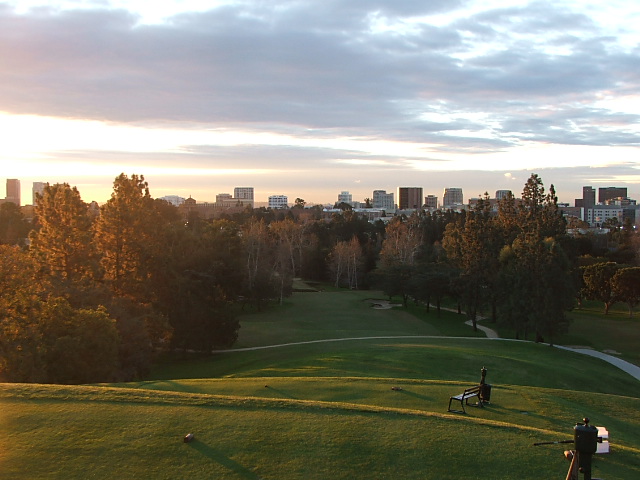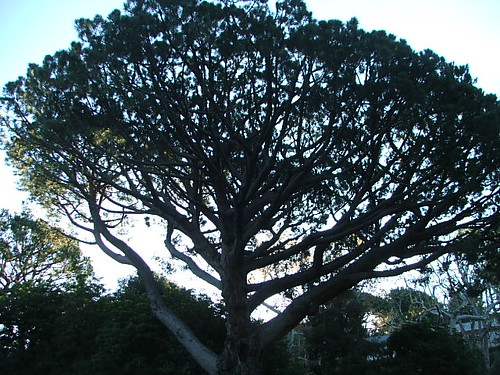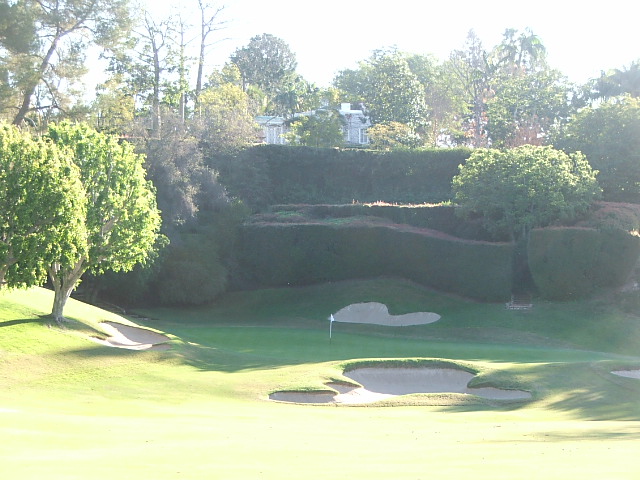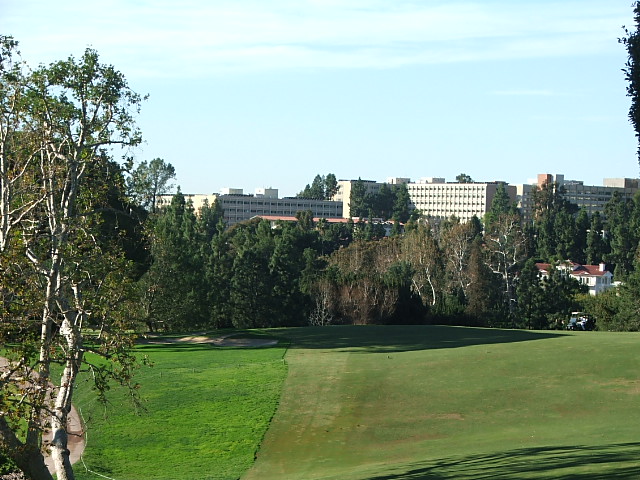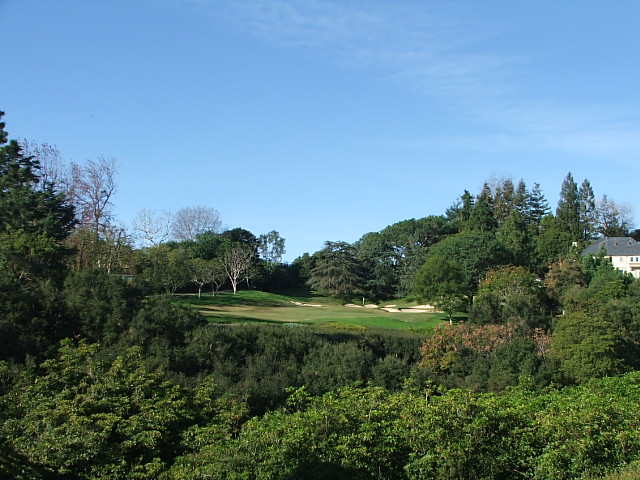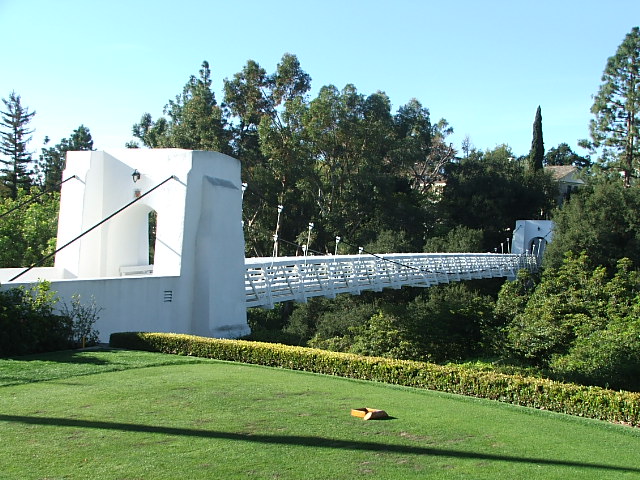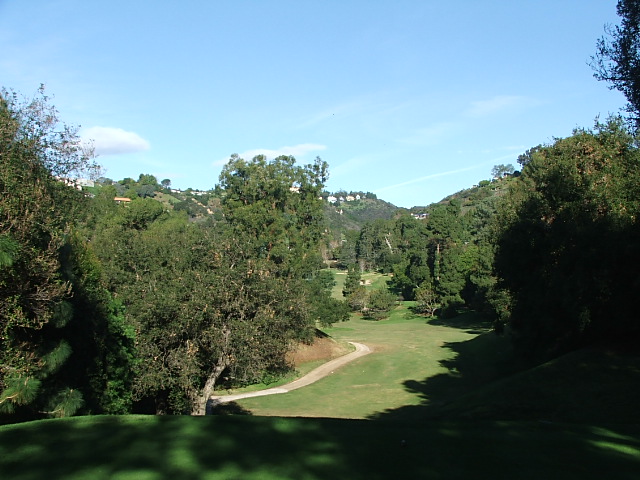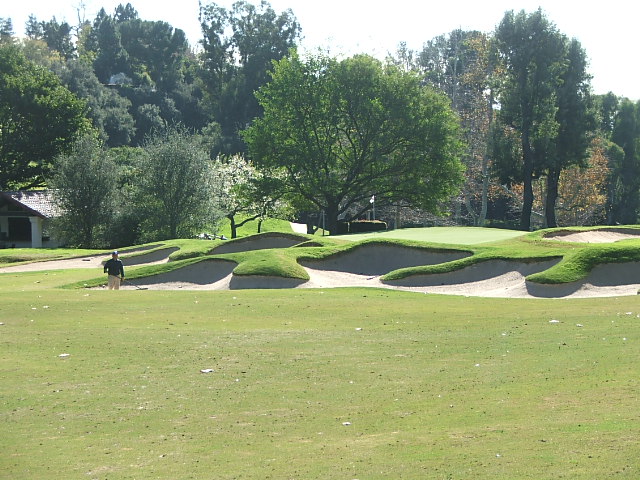
What does a golf-crazed traveler do when he can't get on Los Angeles Country Club (L.A.C.C.) and Riviera is closed for a tour event: play Bel-Air.
Bel-Air Country Club is not ranked in the top 100 courses that I am pursuing: nevertheless, it is one of the courses I most enjoy playing. Bel-Air was designed by George Thomas in 1925. Thomas designed the triumvirate of great courses in this area. Along with Bel-Air, he also designed L.A.C.C. and Riviera. Revisions to the course have been made by Dick Wilson, George Fazio and Robert Trent Jones over the years. As a result, Bel-Air doesn't get the accolades these other two courses get, primarily because some of the changes weren't in keeping with Thomas's original design. As I understand it, most of the changes were cosmetic and the bunkers were tampered with. I'm sure Thomas's original bunkers were better than some of those that are there today; however, I think these criticisms are given too much weight. After all, the core part of what Thomas did is still intact: the routing. And it is a spectacular, world-class routing. Riviera is laid out basically in one large canyon, while L.A.C.C. is routed over rolling and open terrain. Bel-Air is routed through four different canyons and weaves its way in and out of them masterfully.
Bel-Air is one of the most interesting courses in the world to walk because of all the little quirks required to transport you from canyon to canyon. These include having to walk through four tunnels and over one bridge in addition to taking an elevator from the middle of one of the tunnels.
The course starts with one of the most dramatic first tees in the game. It is perched on the top of a hill overlooking U.C.L.A. and the Westwood section of Los Angeles. Set in the canyon below is a short 491 yard par five that is a great starting hole and in keeping with Thomas's design philosophy of a relatively easy starting hole.
Bel-Air's dramatic first hole at sunrise overlooking U.C.L.A. and Westwood
You have to navigate a stream about 80 yards short of the elevated green on your approach to the first of many interesting greens. See the beautiful bunkering that Thomas was known for:
Approach to the first green
Bel-Air feels like a zen garden. After having played golf in Japan, Bel-Air reminds me at times of both Hirono and Naruo. Not so much the routing or the design, but the overall environment: the manicuring of the course, the structure and beauty of the trees and the overall harmony of the place. It feels picture perfect. Of course it helps that every day of the year is 70 degrees with no humidity and that the light in L.A. is beautiful. The mature trees look like sculptures: there are manicured cedar, ficus and huge sycamores with white bark. The west side of Los Angeles is like no other place in America. The amount of wealth in Beverly Hills, Bel-Air, Century City, Holmby Hills, Westwood, Brentwood, Pacific Palisades and the other neighborhoods is stunning. Bel-Air is the epicenter of this La-La Land. Members here lead a charmed life.
Part of the reason the place has such a manicured feel is that the houses around the course are some of the finest in Southern California and are maintained perfectly. Ronald Reagan used to have a house along the course as did Conrad Hilton and Alfred Hitchcock. The names of movie stars and wealthy people who currently live here or used to is too long to list; suffice it to say, it's an impressive group. L.A.C.C. might have the Playboy Mansion, but Bel-Air has the palatial home of the owner of the Girls Gone Wild franchise, Joseph R. Francis. Although, let's not confuse wealth with good taste here. Bobby Jones also shot some of his instructional videos at Bel-Air including the one with W.C. Fields.
In addition to the first hole, I particularly liked the sixth and seventh holes. The first five holes at Bel-Air are routed through one large canyon. After finishing the fifth, you walk through a long narrow tunnel and emerge to play the sixth which is a 377 yard uphill par four with a difficult to hit, well-protected green. The seventh, 391 yards, runs parallel to the sixth but plays down the canyon. Both use the slopes of the hillsides to great affect. The well-bunkered green on the seventh is seen below with the mature hedges behind it:
In addition to the first hole, I particularly liked the sixth and seventh holes. The first five holes at Bel-Air are routed through one large canyon. After finishing the fifth, you walk through a long narrow tunnel and emerge to play the sixth which is a 377 yard uphill par four with a difficult to hit, well-protected green. The seventh, 391 yards, runs parallel to the sixth but plays down the canyon. Both use the slopes of the hillsides to great affect. The well-bunkered green on the seventh is seen below with the mature hedges behind it:
The eighth hole is a 482 yard par five that plays downhill to a green that is protected by water in front and on the left. Your tee shot on the eighth is lined up along the women's dormitory at U.C.L.A. seen in the distance on the right. Note the canting in the fairway.
After finishing the front nine you walk into another tunnel and then mid-way through the tunnel take an elevator up to the clubhouse. The tenth is one of the most interesting and dramatic par threes in the game, and it requires a heroic shot. When the course was being designed Thomas and his collaborators were trying to decide whether a shot could be hit over the 150 yard chasm. Billy Bell, who was helping Thomas, found the only club that was available when they were there and attempted to hit a ball across. This guy had talent. He hit a putter across and thus was born one of the world's great par threes. An interesting tidbit about Thomas is that he never accepted any money for designing some of the best golf courses in the world; he did it purely as a recreational pursuit.
The tenth hole is 200 yards long and it plays longer because you hit uphill. You have to carry the large canyon ravine and avoid the treacherous greenside bunkers. George Peper's The World's 500 Greatest Golf Holes ranks the tenth hole in its top 100. Holes fourteen and seventeen also make his top 500 list. According to Geoff Shackelford's biography of Thomas, The Captain, this hole originally had a punchbowl type green; today it is a two-tiered green.
The walk from tee to green on the tenth is one of the best in the game as well, over the iconic white swinging bridge. It's a miniature suspension bridge and it bounces up and down and moves a little when you walk on it.
The walk from tee to green on the tenth is one of the best in the game as well, over the iconic white swinging bridge. It's a miniature suspension bridge and it bounces up and down and moves a little when you walk on it.
The iconic swinging bridge at Bel-Air
The walk from the 10th to the 11th hole is through another tunnel.
The tunnel from the 10th green to the 11th tee
The eleventh is a 392 yard par four that plays down the hill and dog-legs to the left. It's a classic risk/reward tee shot that rewards a daring shot to the left cutting off the corner. You can see how Thomas routed the course to take full advantage of the canyons and the changes in elevation.
The beauty of the bunkering is seen below on the approach to the 584 yard par five fourteenth hole. Howard Hughes landed his plane on this fairway to catch up with Katharine Hepburn for a game of golf.
The back nine at Bel-Air is the harder of the two due to a stream that snakes through and because the hills are steeper. The greens at Bel-Air are lightning quick and in perfect condition. The course is not particularly long at 6,523 yards from the blue tees, but at a par of 70, is a very good test of golf.
I can't think of a weak stretch of holes on the course and the finish is particularly strong. Both Bobby Jones and Ben Hogan called the seventeenth one of their favovite par fours. The hole doglegs right and slopes right and the sloping fairway sends balls into the rough. Missing the green on your second shot yields a terrible penalty.
One of the most interesting pictures I've taken in my travels is below. It was shot from the middle of the swinging bridge and is a birds-eye view of the oblong kidney-shaped eighteenth green. The eighteenth is a 414 yard par four that plays back up the hill through a canyon toward the clubhouse.
I can't think of a weak stretch of holes on the course and the finish is particularly strong. Both Bobby Jones and Ben Hogan called the seventeenth one of their favovite par fours. The hole doglegs right and slopes right and the sloping fairway sends balls into the rough. Missing the green on your second shot yields a terrible penalty.
One of the most interesting pictures I've taken in my travels is below. It was shot from the middle of the swinging bridge and is a birds-eye view of the oblong kidney-shaped eighteenth green. The eighteenth is a 414 yard par four that plays back up the hill through a canyon toward the clubhouse.
The 18th green as seen from above from the swinging bridge
Bel-Air is not a lesser course then either L.A.C.C. or Riviera and deserves a visit in its own rite. If you get invited, don't wear shorts. It is one of only a handful of courses left in the States where you must wear long pants. I hope you enjoy it as much as I did. I'm living the dream out here!
W Hollywood
During my stay in Los Angeles a new W Hotel was opening, which is where I stayed. Cool and hip, I'm not. I could see them looking at me when I checked in. "Pops looks confused and disoriented," the trendy gal said to herself when I walked in. At a W, it doesn't so much feel like you're checking in as a paying customer. Instead, it feels like trying to gain admission to a hip night club. Anyway, I made it from the red carpet through the ropes.
Staying here required that I learn a whole new vocabulary, none of which made sense to me, but which I will explain to my readers as a public service in case you ever stay at one. The W doesn't have rooms, it has 'wonderful studios', 'spectacular suites' and 'fabulous suites'. Larger rooms include not just a 'wow suite' but also an 'extreme wow suite'. Names like this must make a Valley Girl get all warm and fuzzy at the W.
I had a difficult time re-learning the alphabet. You don't hang a sign on your door that says 'Do Not Disturb'. Instead it says 'When? - Not Now'. It doesn't make any sense. I wanted to work out and looked through the little booklet in my room to see what floor the gym was on. After looking through the book under 'Health Club', 'Gym' and 'Exercise Room' I gave up and went down to the lobby. I had to actually go to the lobby, or should I say 'Living Room', because I couldn't figure out how to dial the operator. Turns out, it's listed on the phone as 'Whatever, Whenever'. Silly me, I should have figured it out. Anyway, the gym is called 'Sweat'. How could I not know that?!
The W Hollywood has three features that make it uniquely L.A. Two floors of the hotel are outfitted with suites that accommodate press junkets with extra large bathrooms to accommodate hair and make-up crews. The spa offers detox services, and, best of all, on the top floor they built a 'bachelor suite' featuring a small raised area that includes a stripper pole. The suite didn't pass muster with the city because it wasn't handicap accessible and they had to take it out. Now it all makes sense to me.
I love L.A.
W Hollywood
During my stay in Los Angeles a new W Hotel was opening, which is where I stayed. Cool and hip, I'm not. I could see them looking at me when I checked in. "Pops looks confused and disoriented," the trendy gal said to herself when I walked in. At a W, it doesn't so much feel like you're checking in as a paying customer. Instead, it feels like trying to gain admission to a hip night club. Anyway, I made it from the red carpet through the ropes.
Staying here required that I learn a whole new vocabulary, none of which made sense to me, but which I will explain to my readers as a public service in case you ever stay at one. The W doesn't have rooms, it has 'wonderful studios', 'spectacular suites' and 'fabulous suites'. Larger rooms include not just a 'wow suite' but also an 'extreme wow suite'. Names like this must make a Valley Girl get all warm and fuzzy at the W.
I had a difficult time re-learning the alphabet. You don't hang a sign on your door that says 'Do Not Disturb'. Instead it says 'When? - Not Now'. It doesn't make any sense. I wanted to work out and looked through the little booklet in my room to see what floor the gym was on. After looking through the book under 'Health Club', 'Gym' and 'Exercise Room' I gave up and went down to the lobby. I had to actually go to the lobby, or should I say 'Living Room', because I couldn't figure out how to dial the operator. Turns out, it's listed on the phone as 'Whatever, Whenever'. Silly me, I should have figured it out. Anyway, the gym is called 'Sweat'. How could I not know that?!
The W Hollywood has three features that make it uniquely L.A. Two floors of the hotel are outfitted with suites that accommodate press junkets with extra large bathrooms to accommodate hair and make-up crews. The spa offers detox services, and, best of all, on the top floor they built a 'bachelor suite' featuring a small raised area that includes a stripper pole. The suite didn't pass muster with the city because it wasn't handicap accessible and they had to take it out. Now it all makes sense to me.
I love L.A.
